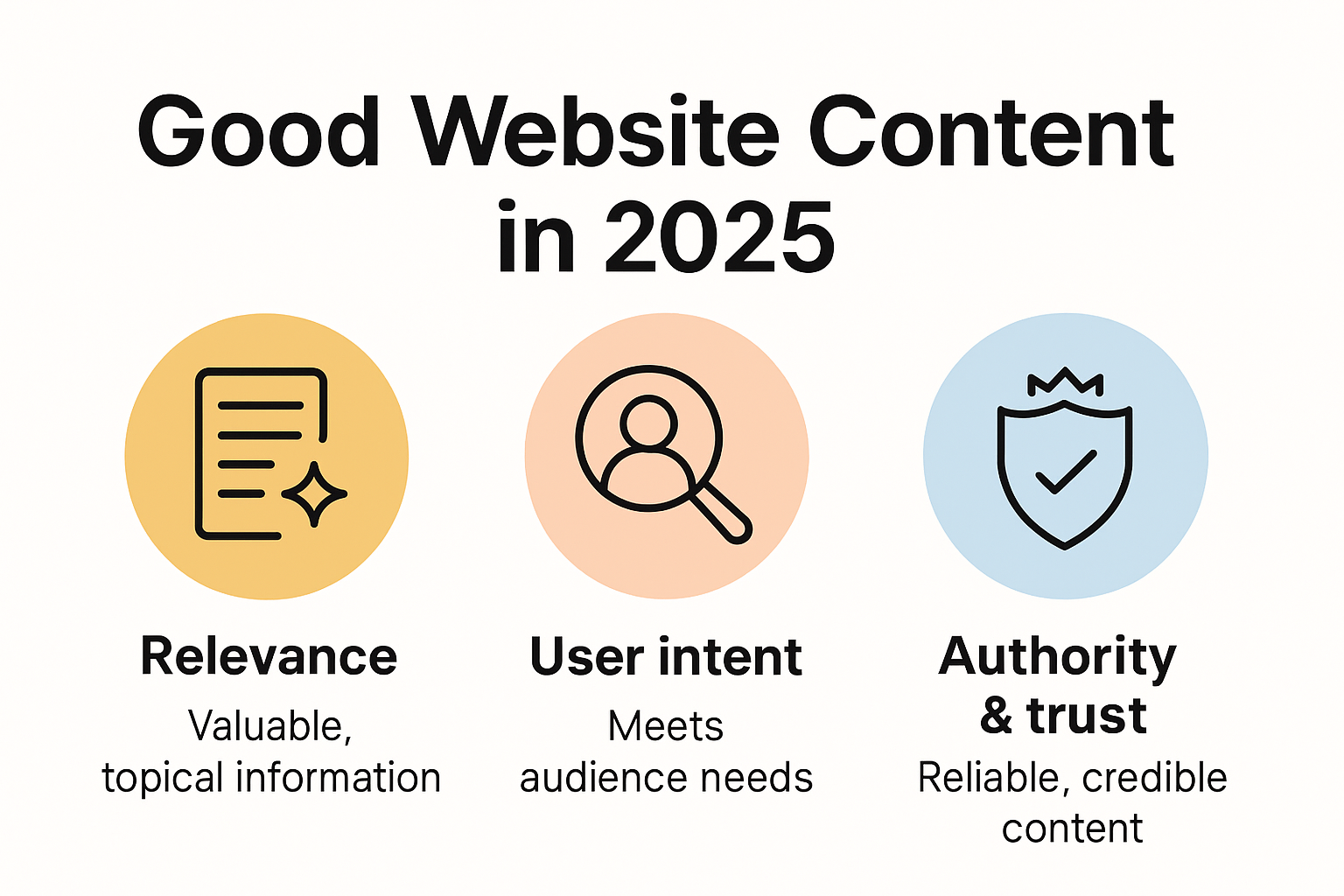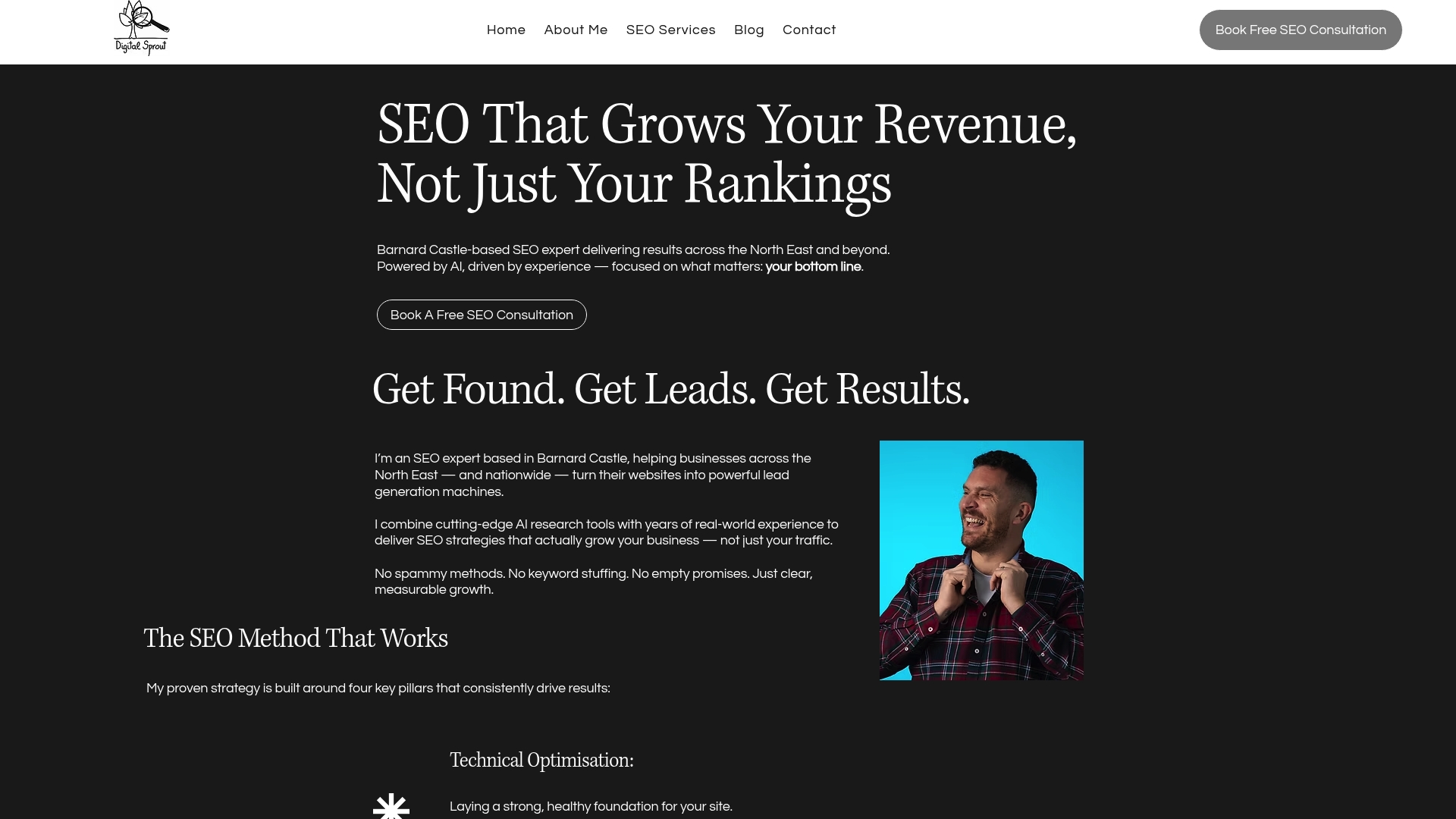What Makes Good Website Content in 2025: A Clear Guide for Modern Businesses
- Mike Dodgson

- Jun 21
- 7 min read
Updated: Jun 22
Website content standards are changing faster than ever. You might think filling a page with keywords still cuts it. Actually, 83 percent of consumers want more video content from brands in 2025. Surprised? Text-heavy sites are slipping behind while brands prioritising relevance and real value are taking the lead in trust and Google rankings. Here is why what works for website content is about to flip on its head.
Table of Contents
Key Elements of Good Website Content
Building exceptional website content requires strategic planning and understanding of modern digital communication. Your website serves as a digital storefront, communicating your brand’s essence, expertise, and value proposition within seconds. Good website content goes beyond mere text - it represents a comprehensive approach to engaging, informing, and converting potential customers.
Content Relevance and User Intent
Understanding user intent sits at the core of creating compelling website content. Modern businesses must craft content that directly answers user questions, solves problems, and provides genuine value. Explore our comprehensive guide on content optimisation to understand how to align your content with precise user needs.

Effective content begins with thorough research into your target audience’s pain points, questions, and search behaviours. This means moving beyond generic information and developing nuanced, specific content that speaks directly to your audience’s challenges. For instance, a plumbing service should not just describe what plumbing is, but detail specific solutions for common household issues, demonstrating deep understanding and expertise.
Technical Structure and Readability
The technical architecture of your content plays a critical role in user engagement and search engine performance. According to research from Bigfork, website content in 2025 must be structured for easy scanning, using clear headings, concise paragraphs, and strategic use of visual elements.
Key technical considerations include:
- Mobile Responsiveness
: Ensure content displays perfectly across all device types
- Semantic Headings
: Use H1, H2, H3 tags to create logical content hierarchy
- White Space
: Allow breathing room between text blocks to improve readability
Mixed Media
: Incorporate images, videos, and infographics to break text monotony
Expertise, Authority, and Trustworthiness
Search engines and users alike prioritise content that demonstrates genuine expertise. According to BIMA’s SEO insights, content must showcase authentic knowledge, providing deep insights that go beyond surface-level information.
This means including:
- Detailed Explanations
: Comprehensive coverage of topics
- Expert Perspectives
: Insights from industry professionals
- Credible References
: Linking to authoritative sources
Clear Authorship
: Transparent information about content creators
Good website content is not a static entity but a dynamic communication tool. By focusing on relevance, technical excellence, and demonstrable expertise, businesses can create digital experiences that not only attract visitors but convert them into loyal customers.
How Content Drives Traffic and Conversions
Content is the primary engine that transforms website visitors into engaged customers. Beyond mere information, strategic content serves as a powerful mechanism for attracting potential clients and guiding them through the conversion journey. Modern businesses must understand how carefully crafted content can systematically drive both traffic and meaningful business outcomes.

Strategic Content Attraction
Traffic generation begins with understanding audience behaviour and creating content that speaks directly to their needs. Dive into our advanced conversion strategies to comprehend how targeted content can transform website interactions.
According to Digital Oft’s content marketing research, visual content dramatically increases engagement. Infographics are 30 times more likely to be read than traditional text articles, while 83% of consumers want more video content from brands in 2025. This underscores the critical importance of diversifying content formats to capture audience attention.
Successful content attraction requires a multi-dimensional approach:
- Keyword Precision
: Target specific search queries
- Compelling Headlines
: Create magnetic titles
- Rich Media Integration
: Use images, videos, and interactive elements
Solving Real Problems
: Address genuine user challenges
Conversion-Focused Content Architecture
Content must do more than attract - it must strategically guide users towards taking action. LocalIQ’s digital marketing statistics reveal that 72% of UK businesses actively use content marketing, with successful strategies emphasising clear user pathways and compelling value propositions.
Effective conversion-driven content includes:
- Clear Call-to-Action Placement
: Strategically positioned conversion prompts
- Trust Signals
: Customer testimonials, case studies
- Transparent Value Communication
: Explicit benefits of taking action
Psychological Triggers
: Urgency, scarcity, social proof
Measuring Content Performance
Transforming content from a cost centre to a revenue generator requires rigorous performance tracking. Businesses must move beyond vanity metrics like page views and focus on meaningful indicators such as engagement time, conversion rates, and actual revenue generated.

Key performance metrics include:
- Conversion Rate
: Percentage of visitors completing desired actions
- Engagement Duration
: Average time spent on content
- Bounce Rate
: Percentage of single-page visits
Lead Quality
: Potential customer value generated
Content is not a static asset but a dynamic tool for business growth. By understanding audience needs, creating targeted experiences, and continuously optimising based on data-driven insights, businesses can transform their website from a digital brochure into a powerful revenue generation platform.
Tailoring Content for Your Target Audience
Creating content that resonates with your specific audience requires a nuanced, strategic approach. Generic messaging no longer suffices in the crowded digital marketplace. Businesses must develop a deep understanding of their target demographic, crafting content that speaks directly to their unique needs, challenges, and aspirations.
Understanding Audience Personas
Successful content strategy begins with comprehensive audience research. Learn more about our targeted content approach to transform your digital communication. According to BIMA’s SEO insights, targeting the right audience with precision-crafted content is critical for driving meaningful engagement and conversions.
Developing detailed audience personas involves:
- Demographic Analysis
: Age, location, income, profession
- Psychographic Mapping
: Values, interests, pain points
- Behavioural Tracking
: Online habits, content consumption patterns
Technological Preferences
: Devices, platforms, communication channels
Content Personalisation Strategies
Personalisation has evolved from a marketing buzzword to a fundamental expectation. Research from Bigfork highlights the importance of creating a content ecosystem that feels tailored and responsive to individual user needs.
Effective personalisation techniques include:

- Dynamic Content Adaptation
: Adjusting messaging based on user interactions
- Segmented Email Campaigns
: Targeted communication for specific audience groups
- Contextual Recommendations
: Suggesting relevant content based on user behaviour
- Interactive Content
: Quizzes, calculators, and personalised assessment tools
Measuring Audience Relevance
Content effectiveness cannot be determined by intuition alone. Modern businesses must implement robust measurement frameworks to understand how well their content resonates with target audiences.
Key measurement approaches:
- Engagement Metrics
: Time on page, scroll depth, interaction rates
- Conversion Tracking
: How different audience segments respond to content
- Feedback Loops
: Direct user surveys and qualitative research
- Competitive Benchmarking
: Comparing performance against industry standards
Tailoring content is an ongoing process of listening, adapting, and refining. By treating your audience as a dynamic, evolving community rather than a static demographic, you create a more meaningful and responsive digital experience. Successful businesses recognise that truly effective content is not about speaking to everyone, but about speaking precisely to someone.
Top Tips to Keep Your Website Content Fresh
Website content is not a static entity but a dynamic ecosystem that requires continuous nurturing and strategic refinement. In the rapidly evolving digital landscape of 2025, businesses must adopt proactive approaches to maintaining content relevance, engagement, and search engine performance.
Regular Content Auditing and Updating
Discover strategies for maintaining content vitality that keep your digital presence sharp and competitive. According to BIMA’s SEO insights, demonstrating expertise, authority, and trustworthiness (E-A-T) remains critical for maintaining content freshness.
Effective content auditing involves:
- Quarterly Content Reviews
: Systematically assess existing content
- Relevance Checking
: Evaluate current information against latest industry developments
- Performance Tracking
: Analyse engagement metrics and user interactions
- Outdated Information Removal
: Eliminate or update obsolete content

Strategic Content Expansion and Diversification
Content freshness extends beyond simple updates. Modern businesses must think strategically about expanding and diversifying their content ecosystem to maintain audience interest and search engine visibility.
Key expansion strategies include:
- Emerging Topic Integration
: Address new industry trends and technologies
- Multimedia Content Creation
: Develop podcasts, videos, and interactive resources
- Depth and Breadth Approach
: Create comprehensive pillar content with detailed supporting materials
- User-Generated Content
: Incorporate customer testimonials and expert contributions
Technical Optimization and Search Intent Alignment
Technical aspects play a crucial role in maintaining content freshness. Search engines prioritise websites that demonstrate ongoing relevance and user value through strategic content management.
Technical freshness considerations:
- Schema Markup Updates
: Ensure structured data remains current
- Internal Linking Refinement
: Create dynamic connection pathways between content
- Mobile Responsiveness
: Continuously adapt to changing device technologies
- Page Speed Optimization
: Maintain fast loading times and smooth user experience
Maintaining website content is an ongoing commitment. Successful businesses view their digital presence as a living, breathing entity that requires consistent attention, strategic thinking, and a willingness to adapt. By implementing these comprehensive approaches, you transform your website from a static information repository into a dynamic, engaging platform that consistently delivers value to your audience.
Frequently Asked Questions
What are the key elements of good website content in 2025?
Good website content in 2025 focuses on relevance to user intent, a strong technical structure for readability, and demonstrates expertise, authority, and trustworthiness (E-A-T).
How can content drive traffic and conversions for my website?
Content can drive traffic and conversions by attracting visitors through targeted strategies, guiding them through clear user pathways, and encouraging action with well-placed calls to action and trust signals.
Why is audience personalisation important for website content?
Audience personalisation is vital as it tailors content to meet specific user needs and preferences, enhancing engagement and increasing the chances of conversion by making visitors feel understood and valued.
How often should I update my website content?
It is recommended to conduct quarterly content reviews and updates to ensure information remains fresh, relevant, and authoritative, aligning with ongoing industry developments and user expectations.
Ready to Turn Content Challenges into Real Growth?
If keeping your website content relevant, authoritative and conversion-focused in 2025 feels overwhelming, you are not alone. The article you just read highlighted growing pains such as aligning content with user intent, improving technical structure and actually seeing content deliver traffic and revenue instead of just page views. These are exactly the areas where many modern businesses struggle to move past old SEO tactics and stand out online.
Stop letting your website drift behind evolving standards. Digital Sprout unpacks your site’s true potential with expert-led strategies tailored to address your unique pain points. From technical optimisation to authority-building pillar pages, we will help you create website content that meets today’s high expectations and delivers measurable results. Visit Digital Sprout today to see how a focused approach can turn more of your visitors into loyal customers. Act now to start building the kind of content that modern users and Google love.
.jpg)


